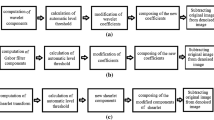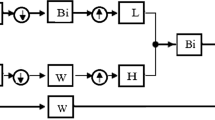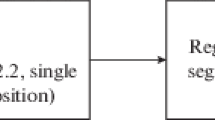Abstract
The quality of welds is very important in some critical industries such as aeronautic manufacturing, pipelines, and civil construction. One of the most important weld inspections is industrial radiography testing. The quality of radiographic images may suffer from some level of blurriness due to poor signal-to-noise ratio, scattered X-rays, and other phenomena. Enhancing image contrast and improving defect detection may be achieved by digital image processing methods. In this study, outcomes from two thresholding algorithms are analyzed and compared. Here, to enhance the radiographic images, the dynamic wavelet transforms have been used long with two different types of thresholds, i.e., the traditional thresholding (including hard thresholding method) and the modified adaptive multi-scale products thresholding (MAMPT). The qualitative operator perception results show that two thresholding methods improved images contrasts and enhanced details visualization. Better results have been achieved by MAMPT especially around the defects regions of image. These results have been obtained by evaluation of the outputs from different algorithms. In addition, MAMPT is about 1.5 orders of magnitude quicker than the hard thresholding method making it more suitable for online weld inspection systems.








Similar content being viewed by others
References
C. Ajmi, J. Zapata, J.J. Martínez-Álvarez, G. Doménech, R. Ruiz, Using deep learning for defect classification on a small weld X-ray image dataset. J. Nondestruct. Eval. (2020). https://doi.org/10.1007/s10921-020-00719-9
P. Sassi, P. Tripicchio, C.A. Avizzano, A smart monitoring system for automatic welding defect detection. IEEE Trans. Ind. (2019). https://doi.org/10.1109/TIE.2019.2896165
E. Yahaghi, M.E. Hosseini-Ashrafi, Enhanced defect detection in radiography images of welded objects. Nondestruct. Test. Eval. 34(1), 13–22 (2019). https://doi.org/10.1080/10589759.2018.1544251
U. Ewert, U. Zscherpel, M. Horkey, J. Kennedy, M. Hutchinson, A new computer based concept for digital radiographic reference images. J. Nondestruct. Test. 7(12), 1–13 (2002)
W. Hou, Y. Wei, J. Guo, Y. Jin, C. Zhu, Automatic detection of welding defects using deep neural network. J. Phys. 933, 012006 (2018). https://doi.org/10.1088/1742-6596/933/1/012006
N. Boaretto, T.M. Centeno, Automated detection of welding defects in pipelines from radiographic images DWDI. NDT E Int. 86, 7–13 (2017). https://doi.org/10.1016/j.ndteint.2016.11.003
S.G. Chang, B. Yu, M. Vetterli, Adaptive wavelet thresholding for image denoising and compression. IEEE Trans. Image Process. 9(9), 1532–1546 (2000)
C. Stolojescu-Crişan, Ş Holban, A comparison of X-ray image segmentation techniques. Adv. Electr. Comput. Eng. 13(3), 85–92 (2013)
A. Macovski, Noise in MRI. Magn. Reson. Med. 36, 494–497 (1996)
S. Jangjit, M. Ketcham, A new wavelet denoising method for noise threshold. Eng. J. 21(7), 141–155 (2017). https://doi.org/10.4186/ej.2017.21.7.141
D. Donoho, I. Johnstone, Ideal spatial adaption via wavelet shrinkage. Biometrika 81, 425–455 (1994)
Q. Pan, L. Zhang, G. Dai, H. Zhang, Two denoising methods by wavelet transform. IEEE Trans. Signal Process. 47(12), 3401–3406 (1999)
M.S. Crouse, R.D. Nowak, R.G. Baraniuk, Wavelet-based signal processing using hidden Markov models. IEEE Trans. Signal Process. 46(4), 886–902 (1998)
S. Mallat, S. Zhong, Characterization of signals from multiscale edges. IEEE Trans. Pattern Anal. Mach. Intell. 14(7), 710–732 (1992)
M. Biswas, H. Om, A new soft-thresholding image denoising method. Proc. Technol. 6, 10–15 (2012). https://doi.org/10.1016/j.protcy.2012.10.002
P. Bao, L. Zhang, Noise reduction for magnetic resonance images via adaptive multiscale products thresholding. IEEE Trans. Med. Imaging 22(9), 1089–1099 (2003)
A. Aggarwal, A. Garg, Medical image enhancement using adaptive multiscale product thresholding, in International A. Conference on Issues and Challenges in Intelligent Computing Techniques (ICICT) (IEEE, 2014). https://doi.org/10.1109/ICICICT.2014.6781362
R. Sethunadh, T. Thomas, SAR image despeckling using adaptive multiscale products thresholding in directionlet domain. Electron. Lett. 49(18), 1183–1184 (2013). https://doi.org/10.1049/el.2013.2186
M. Vijay, Adaptive spatial and wavelet multiscale products thresholding method for medical image denoising, in 2012 International Conference on Computing, Electronics and Electrical Technologies (ICCEET) (2012), pp. 1109–1114
D. Mery, V. Riffo, U. Zscherpel, G. Mondragón, I. Lillo, I. Zuccar, H. Lobel, M. Carrasco, GDXray: the database of X-ray images for non-destructive testing. J. Nondestruct. Eval. 34(4), 42 (2015)
D. Baleanu, H. Aydin, Advances in Wavelet Theory and Their Applications in Engineering, Physics and Technology (InTech, London, 2012)
A. Anshita, A. Garg, Medical image enhancement using adaptive multiscale product thresholding, in 2014 International Conference on Issues and Challenges in Intelligent Computing Techniques (ICICT) (IEEE, 2014), pp. 683–687
A. Rosenfeld, M. Thurston, Edge and curve detection for visual scene analysis. IEEE Trans. Comput. 100(5), 562–569 (1971)
B.M. Sadler, A. Swami, Analysis of multiscale products for step detection and estimation. IEEE Trans. Inf. Theory 45(3), 1043–1051 (1999)
J. Canny, A computational approach to edge detection. IEEE Trans. Pattern Anal. Mach. Intell. 8(2), 679–698 (1986)
Y. Du, M. Tong, L. Zhou, H. Dong, Edge detection based on Retinex theory and wavelet multiscale product for mine images. Appl. Opt. 55(34), 9625–9637 (2016)
P. Kovesi, Phase preserving denoising of images. Signal 4(1), 212–217 (1999)
E. Yahaghi, M. Mirzapour, A. Movafeghi, B. Rokrok, Interlaced bilateral filtering and wavelet thresholding that used for the flaw detection in the radiography of weldments. Eur. Phys. J. Plus (2020). https://doi.org/10.1140/epjp/s13360-020-00119-y
Author information
Authors and Affiliations
Corresponding author
Rights and permissions
About this article
Cite this article
Yahaghi, E., Mirzapour, M. & Movafeghi, A. Comparison of traditional and adaptive multi-scale products thresholding for enhancing the radiographs of welded object. Eur. Phys. J. Plus 136, 744 (2021). https://doi.org/10.1140/epjp/s13360-021-01733-0
Received:
Accepted:
Published:
DOI: https://doi.org/10.1140/epjp/s13360-021-01733-0




